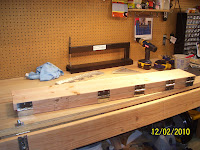
This is not the best pic, but if you look closely at the bottom you will see some flush rivets (appears as though there are no rivets at all) on the spar, and then you see the shop heads from the remaining AN470 universal head rivets. I bucked every single one of these rivets. I find that the spars and ribs are relatively easy to rivet together. Putting the skin on is a different story.
This pic shows the otherside with shop heads of the flush rivets. Flush rivets are installed on the bottom part of the rear spar because this must sit flush against the very last bulkhead of the fuselage where it is bolted into place during the final assembly of the tail. The round headed rivets are used for the remainder of the rear spar since they do not interfere with the fuselage. I had to drill out and replace one of the flush rivets for one of the hinges shown above. For some reason it was the only rivet that slipped out of the hole on me while I was riveting it into place. My attempt to continue to push it back into place was not very successful, and it resulted in a much wider factory head than it started with, and I over-drove the rivet on the other side so the shop head was not formed correctly either.
I managed to get it drilled out without messing up the spar, and replaced it with a much better looking flush rivet. I am feeling much more comfortable with the rivet gun, and I am now much less intimidated when driving the 1/8 inch diameter rivets. They are still very difficult to drill out, however, so I prefer to try to set these rivets correctly the first time.



 A much better "first run" working with the primer this time. The trick is definitely to mix the crap out of the primer and the reducer to ensure that it has the consistency of skim milk, so it will run off the end of my mixing stick for a second or two. You don't wait to start priming after mixing this stuff like you might do with epoxy-based primers. You just pour it in the cup and go.
A much better "first run" working with the primer this time. The trick is definitely to mix the crap out of the primer and the reducer to ensure that it has the consistency of skim milk, so it will run off the end of my mixing stick for a second or two. You don't wait to start priming after mixing this stuff like you might do with epoxy-based primers. You just pour it in the cup and go. 



